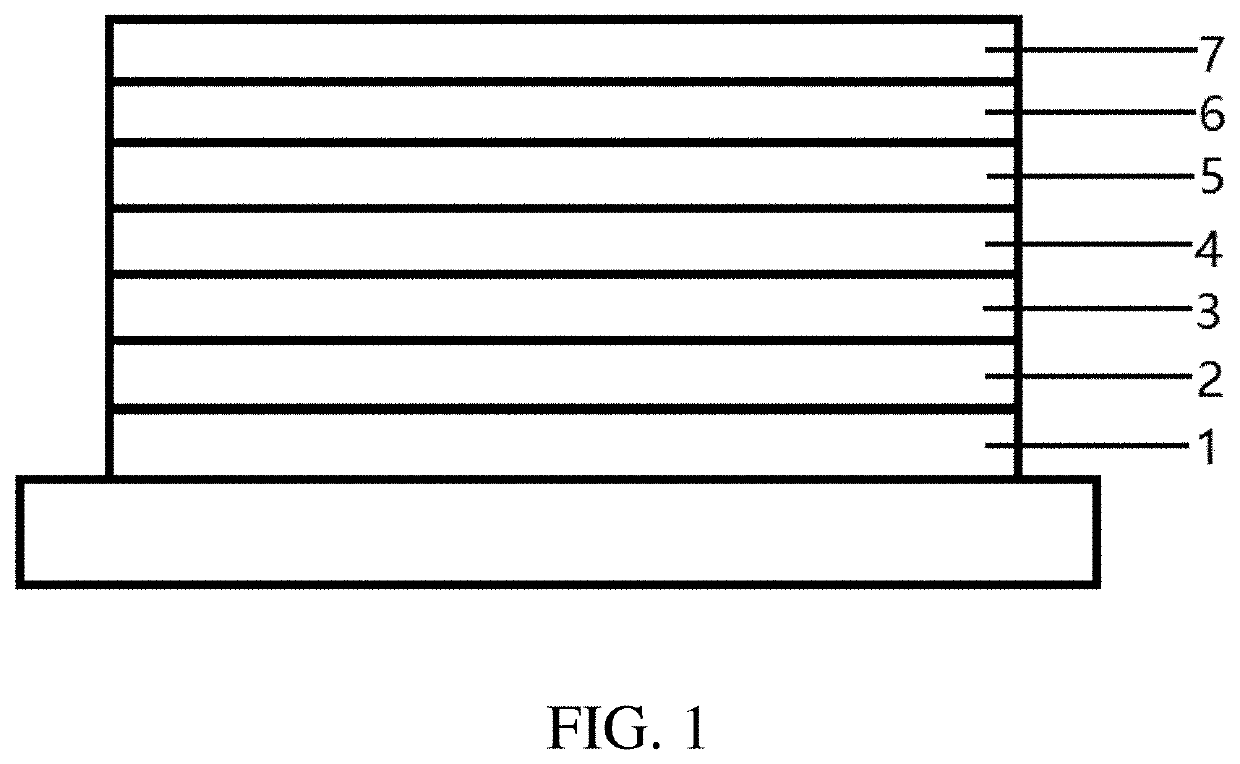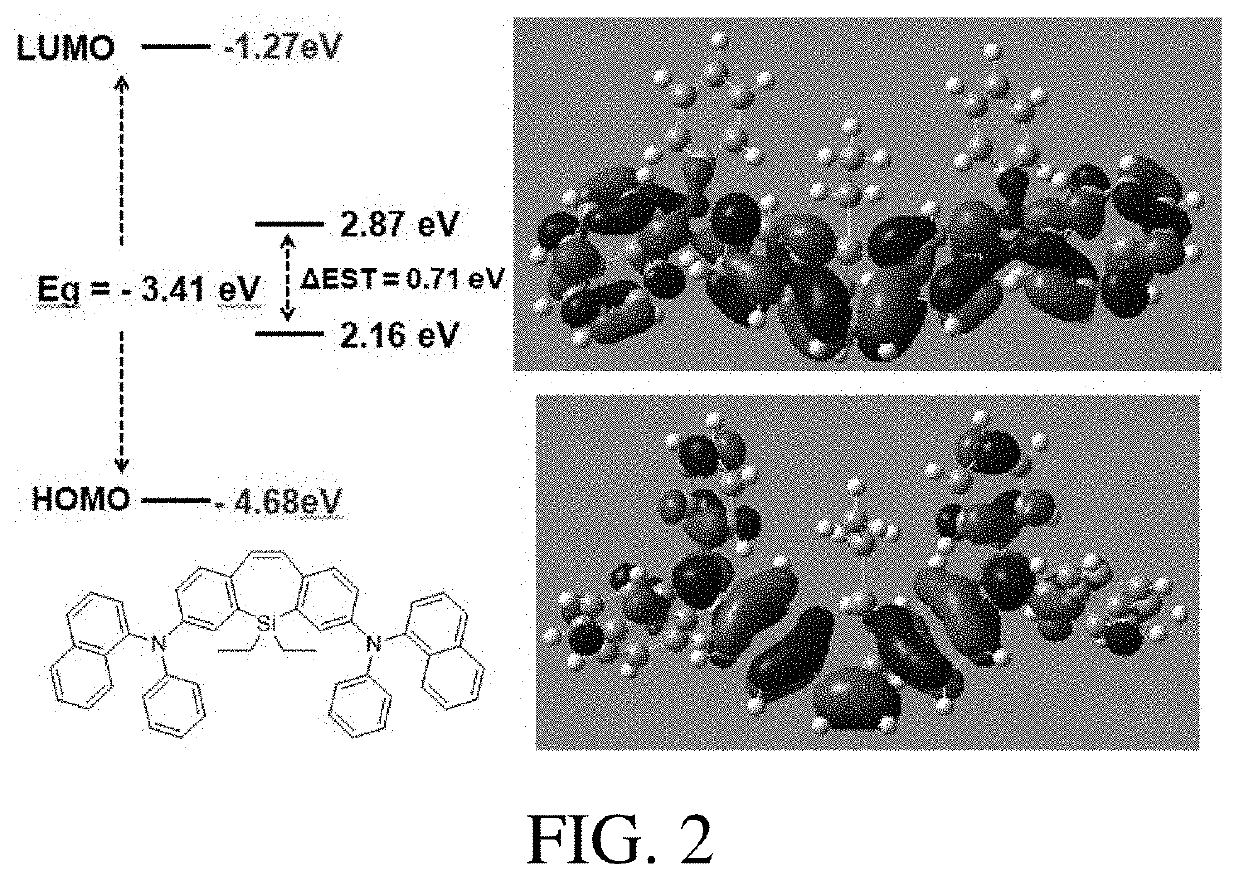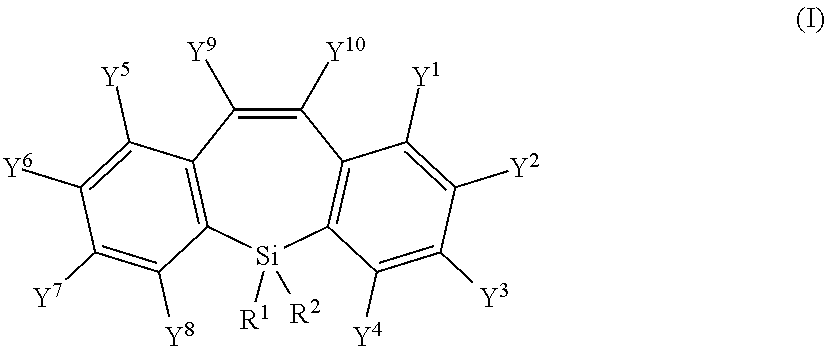Dibenzoheterocyclic compound and preparation method and application thereof
a dibenzoheterocyclic and compound technology, applied in the field of dibenzoheterocyclic compound and preparation method, can solve the problems of limiting the efficiency of blue oleds, limiting the efficiency of devices to a great extent, and low efficiency, and achieves good hole transport performance, favorable to balancing injection and transport, and increase the probability of carrier combination
- Summary
- Abstract
- Description
- Claims
- Application Information
AI Technical Summary
Benefits of technology
Problems solved by technology
Method used
Image
Examples
embodiment 1
[0053]This embodiment provides a dibenzoheterocyclic compound having a structure as shown in the formula SP-01 below:
[0054]A synthesis route of the dibenzoheterocyclic compound shown in the formula SP-01 is as shown below:
[0055]A preparation method of the dibenzoheterocyclic compound shown in the formula SP-01 includes the following steps:
1. Preparation of Intermediate 1-1
[0056]In a dry, nitrogen-flushed 500-ml double-neck round-bottom flask, equipped with a magnetic stirring bar and a reflux tube, firstly a compound A-1 (20.548 g, 1.0 equivalent), NBS (N-bromosuccinimide, 19.578 g, 1.1 equivalent), AIBN (azodiisobutyronitrile, 0.821 g, 0.5 mol percent), and carbon tetrachloride (250 ml) were respectively added, the mixture was stirred for 10 minutes, and finally, the mixture was heated refluxly for 24 hours; after reaction, water (200 ml) was added to quench the reaction. After extraction with ethyl acetate (3*200 ml), the combined extraction liquids were dried over magnesium sulfa...
embodiment 2
[0062]This embodiment provides a dibenzoheterocyclic compound having a structure as shown in the formula SP-02 below:
[0063]A synthesis route of the dibenzoheterocyclic compound shown in the formula SP-02 is as shown below:
[0064]A preparation method of the dibenzoheterocyclic compound shown in the formula SP-02 includes the following steps:
1. Preparation of Intermediate 1-2
[0065]In a dry, nitrogen-flushed 500-ml double-neck round-bottom flask, equipped with a magnetic stirring bar and a reflux tube, firstly a compound A-2 (20.548 g, 1.0 equivalent), NBS (N-bromosuccinimide, 19.578 g, 1.1 equivalent), AIBN (azodiisobutyronitrile, 0.821 g, 0.5 mol percent), and carbon tetrachloride (250 ml) were respectively added, the mixture was stirred for 10 minutes, and finally, the mixture was heated refluxly for 24 hours; after reaction, water (200 ml) was added to quench the reaction. After extraction with ethyl acetate (3*200 ml), the combined extraction liquids were dried over magnesium sulfa...
embodiment 3
[0071]This embodiment provides a dibenzoheterocyclic compound having a structure as shown in the formula SP-03 below:
[0072]A synthesis route of the dibenzoheterocyclic compound shown in the formula SP-03 is as shown below:
[0073]A preparation method of the dibenzoheterocyclic compound shown in the formula SP-03 includes the following steps:
1. Preparation of Intermediate 1-3
[0074]In a dry, nitrogen-flushed 500-ml double-neck round-bottom flask, equipped with a magnetic stirring bar and a reflux tube, a compound A-3 (20.548 g, 1.0 equivalent), NBS (N-bromosuccinimide, 19.578 g, 1.1 equivalent), AIBN (azodiisobutyronitrile, 0.821 g, 0.5 mol percent) and carbon tetrachloride (250 ml) were respectively added firstly, the mixture was stirred for 10 minutes, and finally, the mixture was heated refluxly for 24 hours; after reaction, water (200 ml) was added to quench the reaction. After extraction with ethyl acetate (3*200 ml), the combined extraction liquids were dried over magnesium sulfat...
PUM
| Property | Measurement | Unit |
|---|---|---|
| brightness | aaaaa | aaaaa |
| internal quantum efficiency | aaaaa | aaaaa |
| energy level | aaaaa | aaaaa |
Abstract
Description
Claims
Application Information
 Login to View More
Login to View More - R&D
- Intellectual Property
- Life Sciences
- Materials
- Tech Scout
- Unparalleled Data Quality
- Higher Quality Content
- 60% Fewer Hallucinations
Browse by: Latest US Patents, China's latest patents, Technical Efficacy Thesaurus, Application Domain, Technology Topic, Popular Technical Reports.
© 2025 PatSnap. All rights reserved.Legal|Privacy policy|Modern Slavery Act Transparency Statement|Sitemap|About US| Contact US: help@patsnap.com



